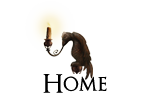I haven't changed my mind as the series has grown and developed - Book 4, Nest of Serpents, was published earlier this year, and it's a cracker, with an injured Drew coming to the aid of the besieged Staglords, and a former foe reappearing at the worst moment. Curtis writes in a vividly descriptive prose style which had me whipping through the pages at a rate of knots, eager to see what happens to Drew and his friends Hector, Gretchen and Whitley as they battle their way through the events of the Lyssian war. A fair splattering of bloodshed and brutality, brave (but badboy) boar warriors, renegade lion lords - and my favourite character of all, Vega the swashbuckling shark pirate - make this a series which should be on every boy's bookshelf. The Times calls it 'a fantasy world...superior to Eragon, and great fun.' I'd second that, and what's more, with CGI becoming ever more clever, I can see these books being made into brilliant films. Dreamworks, where are you?!
Given what I've said above, it's obvious that Curtis is just the man to explore the finer points of
W for Weres
Wolves & other Were Critturs
CJ: Although I've just had a look at Anne Rooney's fabulous previous guest post I already knew the Vampire had just bared his gnashers. Admittedly the Vampire has the advantage of being one step ahead of the Werewolf in the alphabet, as well as in many other mediums. In literature and on the big screen the Werewolf was always late to the party, very much a beast of the 20th Century whilst 'Ol' Toothy' before us was a darling of gothic novels and early European cinema. But for all that, the lycanthrope shares his hairy, scary roots with the Vampire, his legend born out of myth and folklore the world over.
Whilst the Vampire represents something seductive, exotic, equally enthralling and terrifying, your common or garden Werewolf is a beast of pure physical horror. The idea that a normal, happy human being can transform into a hideous ravenous beast is a staple of fables from every continent. The classic Werewolf origin lies firmly in Europe, via French myths such as the Beast of Gevaudan and Grimm's Faerie Tales, cautionary stories that warn children to stay away from the woods and the creatures that lurk within. Little Red Riding Hood didn't half give the lycanthrope bad press. But further back we had the Norsemen, ransacking their way across the continent, their 'Berserkers' leading the way in battle. These were warriors clad in bear or wolf skin cloaks who would supposedly acquire the physical characteristics of these animals, their ferocity in battle unequalled.
But across sea and ocean one can find other shapeshifting legends: Werejackals in the Congo, Wereowls in China, aboriginal terrors in Australia and native American nasties too! Every culture understands and retells the myth of the man turning into monster, and unsurprisingly this has inspired writers across the planet. My own love of the Werewolf comes from the old movies and TV shows I watched as a kid. Universal Studios have a lot to answer for, specifically the appearances of Lon Chaney's Wolfman character in the old black and white 'Creature Features'. But there's also British Fayre that frightened the wits out of me, old Hammer House of Horror shows from the Seventies that I watched with my dad, leaping off the sofa as some furry-faced Werewolf suddenly appeared at a window (see: Children of the Full Moon). As I grew and hair started to appear all over my good self (not in a lycanthropic way, alas, but something far more awkward - curse you, puberty!) my taste in horror expanded accordingly, as I fell in love with now legendary horror movies The Howling and An American Werewolf In London, films that dragged the lycanthrope kicking and howling towards the end of the century.
The Werewolf I know, love and admire is the bipedal beast, walking on two legs, the marriage of man and animal. I'd us the term 'Manimal' here but that particular concept has already been done, to equally inspiring effect upon an eleven year old me in the TV show of aforementioned name! Indeed the special effects wizard behind the make-up in this show was Rick Baker, the man who created the terrifying American Werewolf transformation visual effects, and thereby responsible for many fevered dreams in my youth. That and Jenny Agutter, but we won't go there right now, I don't know who's reading this, Lucy! In folklore the lycanthrope was a man shifting entirely into a wolf, but my favoured version was the one immortalised in The Wolfman, the upright horror which was far more terrifying. Hollywood is entirely to blame for this kind of Werewolf, and for that I thank Hollywood profusely.
So how does the Werewolf inspire me as a writer? My twin loves have always been fantasy and horror, and whilst living on the moors in North Yorkshire many moons ago - American Werewolf country, don'tcha know? - that's where Wereworld first came to me, a marriage of the two genres. I saw more to play with than just Werewolves though, imagining a world where many different kinds of shapeshifters ruled: Bears, Lions, Stags and Rats- these are just a few of the Werelords who appear in the first novel, Rise of the Wolf, and as the series progresses we open the world up to the reader. The canvas is vast, the variety of different animals who can be realised as Werelords almost limitless. As the title of book one intimates, it wouldn't be a Werewolf story without the appearance of a lupine hero, and we have that in Drew Ferran, a farmer's son on the brink of manhood. He's going through changes, hair sprouting all over the shop when the moon comes out, his body burning up, guts twisting about and finding fresh homes. Rise is a rollercoaster ride as we follow Drew, last of the Werewolves and rightful king of the realm, as he's chased across the Seven Realms of Lyssia by the wicking King Leopold the Lion and his agents, out of the frying pan and into the fire, encountering all manner of exotic Werelord along the way.
You might be able to tell that the Werewolf in my story is a good guy. Well, the lycanthrope's had a tough time down the years as everybody's go-to, hairy-arsed villain. I wanted to consider the wolf as the hero here, so Drew really does have to step up to the plate. It was a balance that I felt needed redressing, especially as so many of my childhood nightmares had revolved around the fascinating monsters. Another word I've brought into use into the Wereworld series is 'therianthropy' - rather than just relying upon the word lycanthrope (which obviously is only relevant to a wolf), the therianthrope is any man or woman who can shift into a specific kind of beast. And I'm not making this up - have a looksie, google it, you'll find the word existed before muggins here coined it in Wereworld. So, a Bearlord would be an ursanthrope, a Hawklord an avianthrope etc.
As a result of incorporating these many other therian races into Wereworld, I'm very much hoping I've brought my own spin to Werewolf mythology. Setting it in the fantasy world of Lyssia allows me free reign over the do's and don'ts of the lycanthrope myth - whilst silver is harmful to a shapeshifter in this world, there are other ways of killing a therianthrope: fire, decapitation, a clean blow to the heart. My Werelords can also master the beast within - by controlling their therianthropy this gives them an even greater advantage in battle: brawn and brains.
I'm just editing book five in the Wereworld series presently, Storm of Sharks, which will be released into the wild early next year. A sixth book will follow bringing the tale to a close... for now. If you like your fantasy with a soupcon of horror, chances are Wereworld is a fit for you. Or if you're a lover of all things shapeshifty and lupine, you may enjoy this fantasy romp. But most of all, if you've grown up fearful of the dark things that lurk in the woods, do give Wereworld a read: hopefully I've dispelled the myth that big bad ears, big bad eyes and big bad pointy teeth doesn't always mean big bad news.
Curtis, November 2012
UK: http://wereworldbooks.com
US: http://wereworldseries.com
Twitface: @curtisjobling
SCC: I'm champing at the bit to read Storm of Sharks (more Vega - yay!) and will have to read the whole lot all over again before book six comes out. What a treat in store. Thank you so much for a fab post, Curtis - I'm off to revisit Lon Chaney, and I'm sure others here will be doing the same.
You can buy the first book in Curtis's Wereworld series HERE
Next week: Lauren St John, award-winning author of the White Giraffe series and many other wonderful books, takes on X for Xanthos. See you then!





















No comments:
Post a Comment